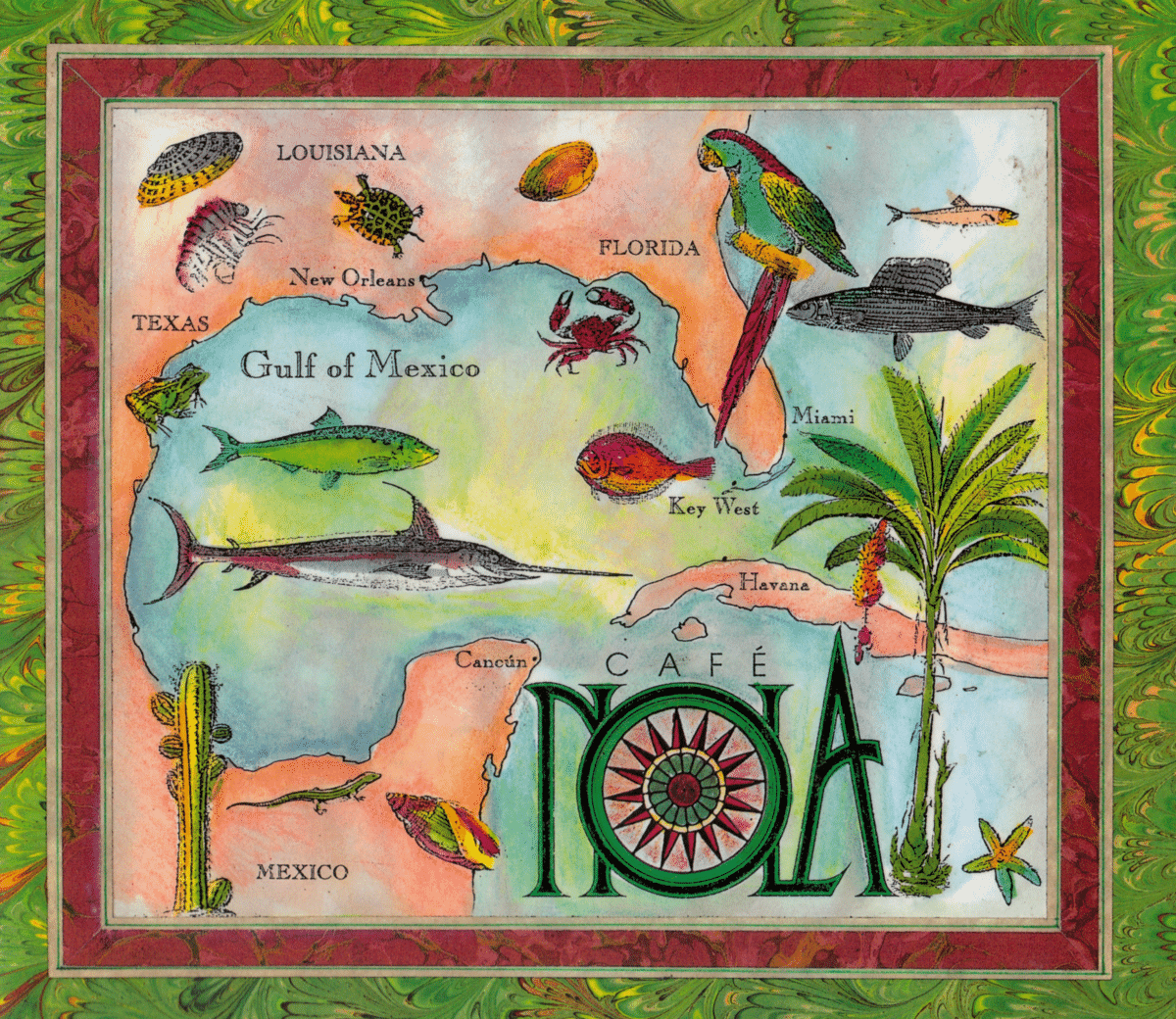New Orleans in Philadelphia
Café Nola was a forerunner of the restaurant renaissance in Philadelphia. The unique eatery served both Cajun and the fancier Creole cuisine of NO (New Orleans) LA (Louisiana) in a relaxed, informal setting, sumptuously designed by Judy DeVicaris. She and co-owner Bill Curry were trendsetters in New Orleans cuisine before Paul Prudhomme introduced Cajun fare to the nation. The restaurant attracted celebrities from all over, as well as a lively mix of diners from Society Hill, Center City and local artists and musicians.
The best-selling dessert was the flaming Bananas Foster. Jambalaya — a mix of andouille sausage, shrimp, crawfish, ham and mussels in a hot and spicy creole sauce — was also a favorite.
A food memoir published in 2013 by David Craig recalled dining at Café Nola.
Another Favorite Meal: Cafe Nola, Philadelphia, October, 1983
When I think of Café Nola, I think of my wife’s favorite appetizer: Angels on Horseback. They were oysters wrapped with bacon and served with an amazing sauce. I generally ordered a seafood entrée, usually a shrimp dish, but I also recall getting their jambalaya. (This was before blackened redfish became a national rage, thanks to New Orleans chef Paul Prudhomme.) On occasions when I wasn’t stuffed, I remember enjoying their pecan pie.
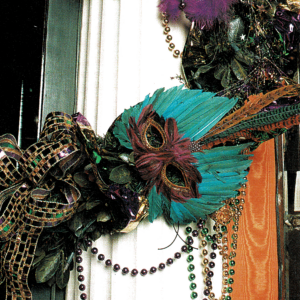
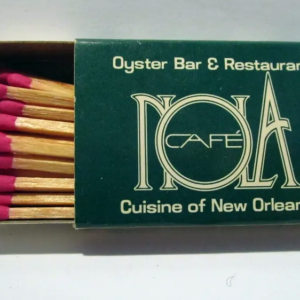
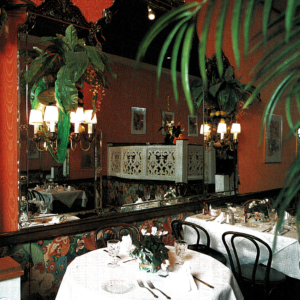
The Hippest Street in Town
After graduating from art school, I found I could support myself by painting signs, hand-lettering menus, and designing advertising in the food and hospitality sector. Restaurants were opening at a furious pace in the 70s. “South Street“, the song written by Philly natives Dave Appell and Kal Mann and performed by The Orlons, topped the charts in the 60s. “The hippest street in town” changed the lackluster reputation of the dull city WC Fields had famously left, and the food scene was exploding.
I had waitressed my way through art school in the 70s, and throughout grad school I bartended in several of the new, hip eateries that were flourishing in Philly. This was long before computers entered our lives. I had some hand-skills, paint and brushes, calligraphy pens and ink, and restaurant experience and connections. I fondly recall meeting Bill Curry, a well-known food and lifestyle columnist and restaurateur, while queued at a quick-copy shop. This was a few years before Café Nola opened in 1981. I assisted him make fixes with ‘white out’ (the liquid correction fluid that pre-dated UNDO on a keyboard) on a typed dinner menu for another iconic restaurant he owned on South Street. That was the beginning of a long relationship with the Curry-DeVicaris creative team. I soon was hired to design Nola menus and ads. Bill always had the “big ideas.” Judy had style and flair. We grew our skills as technology evolved. From copy cameras to desktop publishing, and eventually to websites. The most memorable projects for me were the annual Mardi Gras posters. A limited edition was created each year with a different theme that evoked lavish Fat Tuesday parties. The screen-printed ephemera from that period continues to turn up in flea markets and kitchens. Extras were auctioned off in a Hurricane Katrina fundraiser years later. I am always surprised and delighted when contacted by someone who has saved or found something that commemorates that special time and place.
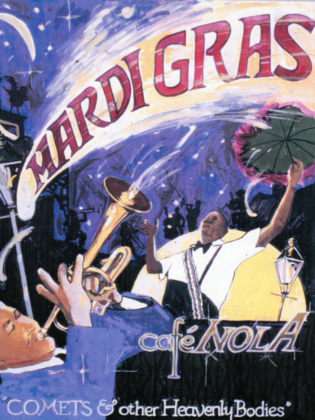
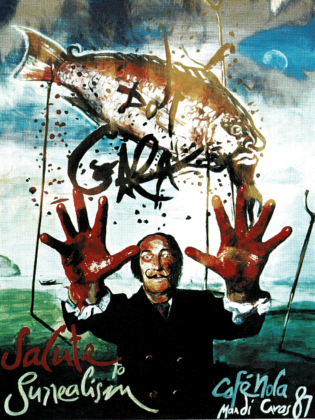
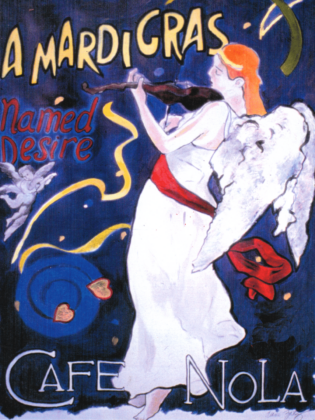
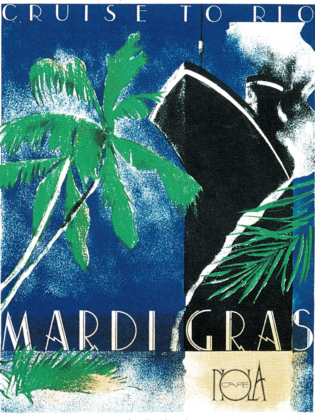
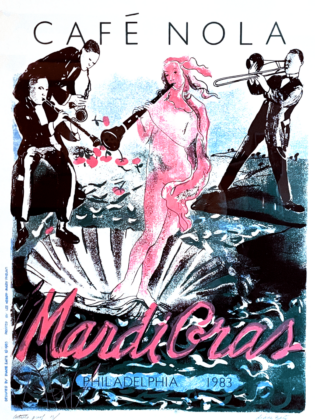
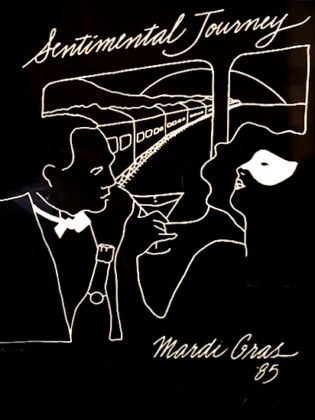
My Mentors, Bill and Judy
Bill Curry and his business partner, Judy DeVicaris, were my mentors, employers, clients, and friends.
Judy, an exceptional interior designer, entrepreneur, mother of five, and member of Les Dames d’Escoffier, taught me about restaurant management, including bookkeeping, food cost and organization. (She also taught me paper maché and had sage advice about child-rearing.) The top floor of Café Nola was a bustling office for several of the pair’s ventures, and it was family. She was a role model who generously shared her expertise with grace and kindness. Bill and Judy’s art direction, encouragement, and support were boundless.
When Judy passed at age 88 in 2021, Kevin Riordan wrote a moving obituary in the Philadelphia Inquirer.
Lush fabrics, deep colors, an Art Deco bar, and an adventurous New Orleans-inspired menu attracted a diverse Philly crowd as well as celebrities such as Vaclav Havel and Bruce Springsteen. “The space my mother designed for Café Nola was influenced by trips she and Bill took to New Orleans. She wanted to capture the beauty of the Garden District. She wanted to bring that atmosphere to South Street,” said Suzanne DeVicaris, who painted the expressive watercolors that were a signature element in the dining room.
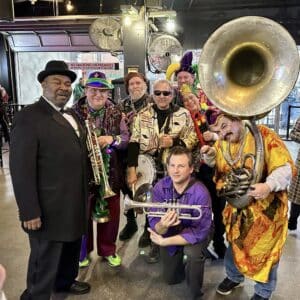
Mardi Gras in Philly
Café Nola hosted annual Mardi Gras dinners and events that drew crowds to the authentic flavor of New Orleans. When it closed, there were other iterations that used the name and logo in various locations run by different proprietors. None succeeded in holding a candle to the original. More New Orlean’s style restaurants opened, and the sophisticated scene turned into raucous crowds, but the annual South Street Mardi Gras parade that began forty years ago is still led today by the same The Wild Bohemians.
In New Orleans, Fat Tuesday is a legal holiday. But on Philadelphia’s South Street, Café Nola created an atmosphere that captured the essence of New Orleans’ flavor and Mardi Gras. ![]()
